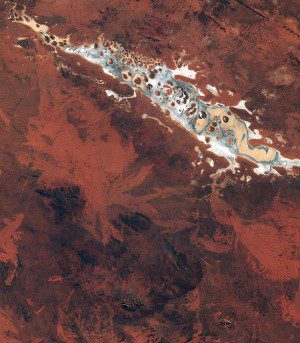
This image was captured by ESA's Sentinel-2A satellite, showing Lake Amadeus, the largest salt lake in Australia's Northern Territory, just 50 kilometers north of Uluru/Ayers Rock. (Credit: Copernicus Sentinel data (2015)/ESA)
This image captured by Sentinel-2A on July 13, 2015, features Lake Amadeus in Australia's Northern Territory.
It shows the variety of the sandy, rocky and salty formations within the lake. Approximately 180 kilometers long and 10 kilometers wide, Amadeus is the largest salt lake in the Northern Territory, just 50 kilometers north of Uluru/Ayers Rock.
Lake Amadeus contains up to 600 million tons of salt. However, harvesting isn't feasible because of its remote location. Owing to the area's aridity, the surface of Lake Amadeus often is a dry salt crust. When rainfall is sufficient, it becomes part of an east-flowing drainage system that eventually connects to the Finke River.
A UNESCO World Heritage Site and one of Australia's most-recognizable landmarks, Uluru/Ayers Rock is a large sandstone rock formation standing 348 meters high, rising 863 meters above sea level and with a circumference of 9.4 kilometers.
Also clearly visible in the lower-central part of the image are the Petermann Ranges. These mountains run 320 kilometers across the border between Western Australia and the southwest corner of the Northern Territory. Their highest point is 1,158 meters above sea level. The range was formed about 550 million years ago as compression folded a section of Earth's crust.

